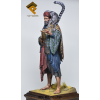120mm resin figure. Painted by Konstantin Pinaev.
Please note that this is a 3D-Printed Model.
Base is NOT included.
Limited Edition
Piracy, defined as the act of attacking and robbing a ship or port by sea, had a long history in the ancient Mediterranean stretching from the time of the Egyptian pharaoh Akhenaten (r. 1353-1336 BCE) and throughout the Middle Ages (c. 476-1500 CE).
Egyptian records substantiate piratical activities in the Mediterranean centuries earlier and Roman accounts report its continuance for centuries afterwards. Piracy was engaged in by governments and was often considered a legitimate act of war. Pirates were not always the “outsiders” flying under their own flag but were frequently employed by governments and were encouraged in their piracy by the slave trade which continued throughout antiquity. Long after Pompey had defeated the Cilician pirates, Rome continued to rely on them for slaves for the empire and, after that empire fell, piracy and the slave trade continued for centuries. Piracy was fuelled by the slave trade to such a degree that normally law-abiding sea-traders, such as the Phoenicians, resorted to piracy in kidnapping citizens from coastal towns and ports to be sold as slaves. The slave trade was extremely profitable. By the time of the Roman Empire , a healthy adult male slave between the ages of 15-40 cost 1,000 sesterces ($3,000.00) and a healthy adult female around 800 sesterces ($2,400.00) while those older or younger would be cheaper.
The Cilician pirates were mostly composed of coastal fishermen in Cilicia Trachea (Rough Cilicia) where the earth was not conducive to farming. When these people felt they weren't making a sufficient living from the sea, they turned to piracy either by outfitting their own small boat or joining the crew of one already established. The typical pirate ship was epitomized in the design of the lembus , a small, agile craft which could easily navigate coastal waters (where the shipping lanes were), intercept and board other vessels, and disappear into coves and harbours inaccessible to larger ships. A member of the crew would have a share in the spoils, could one day perhaps afford one's own ship and crew, and could at least imagine a life more promising and exciting than fieldwork in unrewarding terrain.
The Cilician pirates grew in power as the Seleucid Empire, which controlled the coast of Cilicia, began to wane steadily after 110 BCE. Rome had first become involved in Cilicia in 190 BCE when they took the region from the Seleucids but allowed client kings to continue their rule and ignored the problem of piracy as it did not affect Roman interests. By 103 BCE, however, the problem had grown more serious and Rome sent Marcus Antonius (l. 143-87 BCE, grandfather of Mark Antony ) who conquered so-called Smooth Cilicia and then, between 78-74 BCE, sent consul Publius Servilius Vatia (served 79 BCE) who conquered Rough Cilicia but neither did anything to curtail piracy. By 67 BCE, Pompey the Great was in the region campaigning against Mithridates VI of Pontus when he found that Mithridates VI was employing Cilician pirates to interfere with the Roman war effort. Pompey divided the Mediterranean into 13 districts, assigning a fleet and commander to each. As one district was cleared of pirates (who were captured or killed), that fleet would join another in the next district and, by this process, Pompey drove the Cilician pirates down to the last district off the coast of Coracesium Cilicia where he defeated them in 67 BCE. Pirates were usually crucified, beheaded, or sold into slavery themselves, but Pompey chose the path of rehabilitation and had many of the more promising pirates relocated to central Cilicia where they became productive farmers and members of their communities.
After Pompey's victory over the pirates (and later victory over Mithridates VI in 63 BCE), Rome still needed slaves and pirates were still the central agents of the slave trade. Pompey's own son, Sextus Pompey (l. 67-35 BCE) became a pirate and commanded a pirate fleet. Pompey's 67 BCE victory was only a temporary stopgap which helped win the Mithridatic Wars, not the end of piracy in the Mediterranean. In 31 BCE, the Roman general Octavian defeated the forces of Mark Antony and Cleopatra VII at Actium to become Augustus Caesar (r. 27 BCE – 14 CE), the first Roman emperor . The empire needed even more slaves than the Roman Republic had and only the Cilician pirates were back in business. The Cilician city of Side was the administrative centre for the slave trade in the Mediterranean and became one of the wealthiest because of it. Roman slave traders lavished gifts and money on the city. Cilician pirates were still plying their trade in the same ways they always had at the time of the writer Pausanias (l. 110-180 CE) who reports on their method of masquerading as legitimate merchants to lure unsuspecting citizens toward their ships. The pirates would announce some quantity of goods they had for sale, wait until a good number of people had either boarded the ship or gathered near to it, and then haul as many as possible aboard and sail away. Unlike earlier, Rome did nothing to stop this practice or curtail piracy in any way because now they were benefiting from it. The Cilician pirates were, in effect, working for the Roman Empire.















